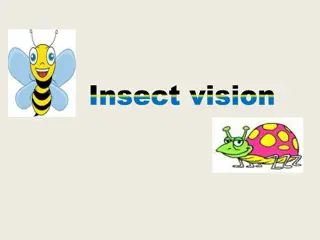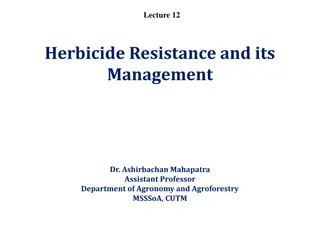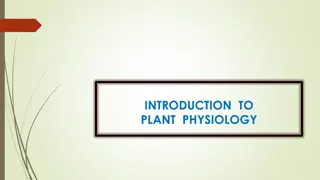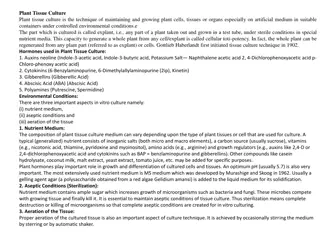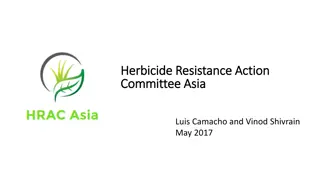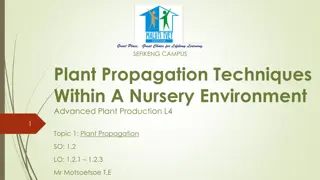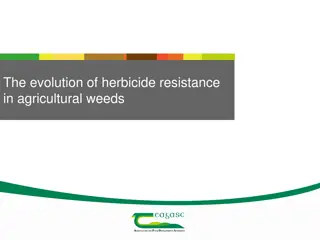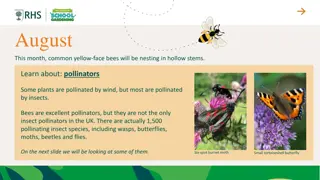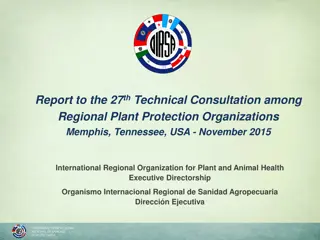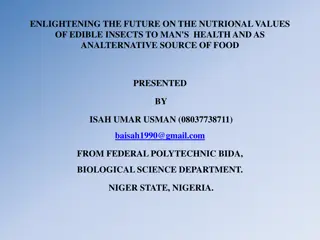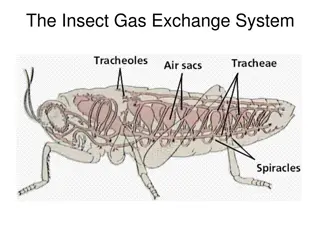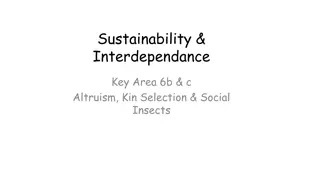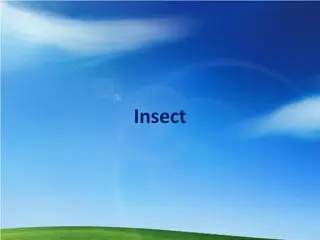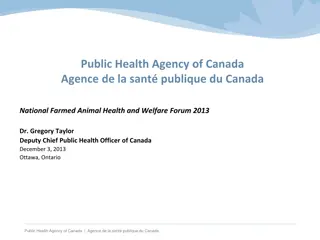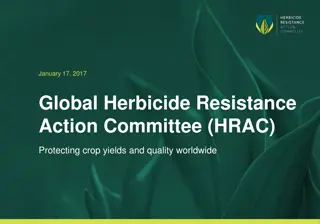
Managing Insect Pests with Resistant Plant Varieties
Discover the benefits of growing insect-resistant crops and the importance of resistance plant varieties in reducing pesticide reliance. Learn about the history of plant resistance to insect pests and how plants develop characteristics to defend against attacks. Explore the concepts of plant resistance to insects and the definitions provided by Painter and Maxwell.
Download Presentation

Please find below an Image/Link to download the presentation.
The content on the website is provided AS IS for your information and personal use only. It may not be sold, licensed, or shared on other websites without obtaining consent from the author. If you encounter any issues during the download, it is possible that the publisher has removed the file from their server.
You are allowed to download the files provided on this website for personal or commercial use, subject to the condition that they are used lawfully. All files are the property of their respective owners.
The content on the website is provided AS IS for your information and personal use only. It may not be sold, licensed, or shared on other websites without obtaining consent from the author.
E N D
Presentation Transcript
510 . . aldawood@ksu.edu.sa Email: aldawood@ksu.edu.sa Tel: 467- 8246 ) EERU (
Managing Insect Pests with Resistant Plant Varieties Introduction Pesticides reliance can be reduced by growing insect-resistant crops. Availability of resistance plant varieties is the most effective, economical and environmentally safe tactics. Some plant varieties are resistant while others are sensitive which is related to certain physiological, morphological characteristics inherited by plants to defend from attack.
Managing Insect Pests with Resistant Plant Varieties Resistance is a merit for a plant variety to persist and reproduce. Usually resistant varieties have favorable characteristics such as yield quality and quantity and resistant to insect pests. Brief History of Resistance The earliest plant resistance to insect pests was recorded in the late eighteenth and early nineteenth centuries. Underhil wheat variety was the earliest documented insect resistant plant variety against Hessain Fly.
Managing Insect Pests with Resistant Plant Varieties The example of using resistant variety of grapes to Phylloxera (Aphids species attacking roots). Susceptible European grapes grafted on American resistant grapes.
Managing Insect Pests with Resistant Plant Varieties Definition of Plant Resistance to Insects Resistance of plants to insect is the property that enables a plant to avoid, tolerate or recover from injury by insect populations that cause greater damage to other plants of the same species, similar environmental conditions. This property generally derives from certain biochemical and morphological characteristics of plants which affects the behavior and/or the metabolism of insect as to influence the relative degree of damage caused by these insects.
Managing Insect Pests with Resistant Plant Varieties Painter and Maxwell definitions of Plant Resistance to Insects Those characters that enable a plant to avoid, tolerate or recover from attacks of insects under conditions that would cause greater injury to other plants of the same species (Painter, R.H., 1951). Those heritable characteristics possessed by the plant which influence the ultimate degree of damage done by the insect (Maxwell, F.G., 1972).
Managing Insect Pests with Resistant Plant Varieties Insects and Host- Plant Relationship Mechanism of plant resistance to insect is important to understand Insect Aspects The insect aspects of the insect-plant interaction is often described as a series of steps, in time and space, that lead to suitability of a plant for the insect.
Managing Insect Pests with Resistant Plant Varieties Finding the general habitat Insect locate the general area of the host by means un-related to plant. Physical stimuli such as light, wind, gravity, temperature and humidity may help orient dispersing insects to the overall location of the host. Finding the host plant Most insects rely on vision/color, smell/ order, shape, form, size, of the host plant. But once on contact with host plant insect use short range stimuli e.g., Physical such as exciting tactile receptors
Managing Insect Pests with Resistant Plant Varieties and chemical such as exciting chemoreceptors on tarsi, antennae and mouthparts. Accepting of the plant as a proper host After host finding insect may take a test bites in chewing insect while probing in sucking insect to confirm host recognition. Continues feeding seemingly is governed by the stimulation from various chemicals.
Managing Insect Pests with Resistant Plant Varieties Major physical factor involved in acceptance of a host may include the toughness of the leaf and stem, leaf surface wax and Pubescence (density and types of hairs). Sufficiency of the pant for requisites Sufficiency of the pant as host is finally determined during feeding. If nutrients are adequate and no toxicity occurs, the insect complete development within a normal time period and become an adult. Also, longevity and fecundity of insect indicate the host sufficiency.
Managing Insect Pests with Resistant Plant Varieties The plant aspects The response of the insect to host plant depends on the morphological and physiological characteristics of the plant. Morphological Characteristics Morphological Characteristics of the plant my produce physical stimuli. Variation in foliage size, shape, colour and presence or absence of glandular secretions may determine the degree of acceptance or utilization by insects. Moreover, presence of pubescence and tissue toughness effect insect feeding and mobility.
Managing Insect Pests with Resistant Plant Varieties Physiological Characteristics Physiological Characteristics of the plant involve chemical that are the products of plant metabolism. Such chemicals are the results of primary and secondary metabolic processes. The relationship between plant chemical stimuli and insect response is a form of chemical communication between these organisms and such chemicals are called semiochemicals. Pheromones Promote communication between members of the same species.
Managing Insect Pests with Resistant Plant Varieties Allelochemics Promote communication between members of the different species. Metabolites in the plants stimulate responses are kind of allelochemics. Allelochemics are further divided into Allomones and Kairomones Allomones are mostly defense chemicals producing negative response in insects and reducing the chance of contact and utilization e.g., replants, oviposition and feeding deterrents.
Managing Insect Pests with Resistant Plant Varieties Kairomones are advantageous to insect, promoting host finding, oviposition and feeding. E.g., attractants, arrestants, excitants and stimulants. Host Plant Selection Host plant selection by insect usually involves both primary and secondary metabolites. Taste and smell are analyzed by the insect to test whether it is a suitable host if so, interaction and association between the insect and host plant will continue.
Managing Insect Pests with Resistant Plant Varieties Therefore, the study of the association and relations between insect and host plant is very important in breeding programs to develop resistant plant varieties. Good understanding of the association and relationships leads to the understanding of susceptibility/ immunity gradient and enhanced efficient development of resistant cultivars.
Managing Insect Pests with Resistant Plant Varieties Mechanisms of Resistance Resistant cultivars behave in many different ways to reduce the effects of insect attack. For normal insect growth and development insect have some requisites in proper amounts and at specific time. Resistant cultivars do not provide these requisites which interrupt the normal host selection process.
Managing Insect Pests with Resistant Plant Varieties The mechanism of resistance involves new allomones or increased levels of existing ones and reduced levels of Kairomones. The mode or mechanisms of resistance include: nonpreference, antibiosis and tolerance. Nonpreference Nonpreference refers to plant characteristics that lead insects away from a particular host that include the activities of both plant and insect. It is also called Antixenosis means against or expelling the guests.
Managing Insect Pests with Resistant Plant Varieties With nonpreference normal insect hehavior is impaired in such a way as to reduce chances of insect s using plant for oviposition, food, or shelter. Nonpreference can be expressed in a cultivar through either allelochemic or morphological characteristics. Allelochemic Nonpreference This form is common among plants and sometimes causing them to be totally rejected by the insects, e.g., spotted cucumber beetle and other Diabrotica species on cucurbits.
Managing Insect Pests with Resistant Plant Varieties Morphological Nonpreference This form of nonpreference results from plant structural characteristics which interrupt normal behavior by physical means, e.g., Corn earworm prefers to oviposit on pubescent surfaces. Feeding activities are also effected by morphological characters including pubescence, tissues characteristics and gummy exudates.
Managing Insect Pests with Resistant Plant Varieties The more less diameter in alfalfa stem make it resistant against egg laying of alfalfa weevil The more less diameter in wheat stem make it resistant against egg laying of wheat sawfly. Toughness of cucurbit vines make it resistant to cucurbit vine borer. Use of Nonpresference Nonpreference resulting from the presence of allelochemicals may not be practical in the absence of other alternative host plants.
Managing Insect Pests with Resistant Plant Varieties This type of resistance break down easily because insect has to feed on such cultivar if not find any other susceptible host. Nonprefence resulted from nonprefered morphological characteristics is more practical and can not be easily break down.
Managing Insect Pests with Resistant Plant Varieties Antibiosis Antibiosis is the most desired objective of the plant breeders. Antibiosis impairs insect metabolism through the consumption of the plant metabolites. Allelochemicals are frequently associated with antibiosis. Examples Cyclic hydorxamic acids in corn (DIMBOA) Gossypol and related compounds in cotton. Steroidal glycosides in potato Saponins in alfalfa
Managing Insect Pests with Resistant Plant Varieties The quantity and quality of the primary metabolites may be important in conferring antibiosis, e.g., imbalances of sugars and amino acids that result in nutritional deficiencies for insects feeding on plants Pea cultivar with low amino acid levels and increased sugar contents show resistance to the pea aphid. Rice cultivars deficient in asparagine cause reduced fecundity in the brown plant hopper.
Managing Insect Pests with Resistant Plant Varieties Symptoms of insects affected by antibiosis Death of young immatures Reduced growth rate Increased mortality in pupal stage Small adults and reduced fecundity Shortened adult lifespan Morphological malformations Restless and other abnormal behavior
Managing Insect Pests with Resistant Plant Varieties Tolerance Tolerant plants has the ability to give satisfactory yields in spite of injury levels that would debilitate nonresistant plants. Mechanisms of tolerance are poorly understood. Known components of this kind of resistance include General vigor Compensatory growth in individual plants/ plant population Wound healing Mechanical support in tissues and organs
Managing Insect Pests with Resistant Plant Varieties Changes in photosynthate partitioning An important advantage of tolerance is that it places no selection pressure on insect populations as do nonpreference and antibiosis mechanisms. Without selection pressure variants do not develop that can overcome the resistance. Its disadvantage is that insect population built up in very large numbers and may cause epidemics in the area causing problems to the other crops.
Managing Insect Pests with Resistant Plant Varieties Examples Some corn cultivars have the ability to repair and replace roots fed upon by corn cutworms Such tolerance allows the plants adequate water and nutrient uptake and compensate damage despite heavy feeding. Moreover, tolerant genotypes developed greater root volume with rootworm feeding as compared to healthy ones.
Managing Insect Pests with Resistant Plant Varieties Apparent Resistance It is not considered as true resistance and some time also called ecological resistance or pseudoresistance. Its expression is heavily based on environmental conditions than on genetics. The characteristics of this resistance are temporary and cultivars are potentially susceptible. Apparent resistance is important in insect pest management but its use must be carefully synchronized with prevailing environmental conditions.
Managing Insect Pests with Resistant Plant Varieties There are three types of apparent resistance including host evasion, induced resistance and host escape. Host Evasion Plant passes through susceptible stage quickly or at a time such that its exposure to potentially injurious insects is reduced. Host evasion is accomplished by growing early maturing varieties, e.g., Planting fast maturing cultivars of cotton protect them from boll weevil, pink bollworm, corn earworm, tobacco budworm
Managing Insect Pests with Resistant Plant Varieties Sometimes evasion with early maturing varieties is confused with true resistance. To test early varieties for resistance, they can be planted later than usual and inspected for late-season injury. Induced Resistance It is a form of temporary resistance derived from plant condition or the environment. Factors like fertilization or changes in soil moisture levels may make plants more tolerant of insect than under other circumstances.
Managing Insect Pests with Resistant Plant Varieties Nitrogen and potassium levels are known to affect aphid populations on plants. High nitrogen level usually allow increase in insect survival, but opposite may occur for high level of potassium. Therefore, a proper balance of these nutrients in fertilizers is recommended for inducing resistance in plant against aphids. Recently attention has been given to the role of Phytoalexins which induce plant resistance to insects. Phytoalexins are phenolic compounds produced by the plants when attached by pathogens
Managing Insect Pests with Resistant Plant Varieties or insect pests. The mechanism involved is the accumulation of allomones which triggered by injury or other environmental conditions. Host Escape This category explains the lack of infestation of susceptible plants in a population of otherwise infested plants. The presence of an un-infested plant may not mean that it is resistant and emphasizes that escapes occur in most plant population even with heavy insect infestation. No reason found.
Managing Insect Pests with Resistant Plant Varieties Genetic Nature of Resistance Plant breeding activities aimed at developing resistance rely heavily on a knowledge of genetic background for the resistance. Such knowledge provides a quantitative basis for designs to recombine genes and select for proper characters. It also allows the identification of stable resistance factors that will ensure to reduce pest population.
Managing Insect Pests with Resistant Plant Varieties The gene-for-gene relationship In pest populations there are individuals with virulent genes that allow a pest species to overcome resistance. One or more virulent genes may be present that allows an individual pest to overcome the effect of one or more plant genes responsible for resistance. This principle is called gene for gene relationship.
Managing Insect Pests with Resistant Plant Varieties In the gene for gene relationship plant cultivars are resistant because they have a resistant allele at a gene locus that corresponds to an avirulent (susceptible) allele at a equivalent locus of an insect e.g., The resistant gene in the host may code for a protein toxic to the insect and a corresponding virulent gene in the insect may code for an enzyme that detoxifies the toxic protein of the plant. This circumstance allows virulent individuals to attack the otherwise resistant plant, and over a period of time the virulent
Managing Insect Pests with Resistant Plant Varieties genotype can replace the avirulent genotype. Eventually, the effectiveness of the resistant cultivar would decrease. Different populations of an insect species that vary in their virulence to a cultivar are called biotypes. Vertical resistance It refers to the cultivars with resistance limited to one or a few pest genotypes. Horizontal resistance It describes cultivars that express resistance against a broad range of pest genotypes.
Managing Insect Pests with Resistant Plant Varieties Resistance classes based on mode of inheritance Oligo resistance Oligo resistance is also called major gene resistance and is conferred by one or only few genes. This type usually produces vertical resistance against insects and may be inherited through dominant or recessive genes. Single gene dominant resistance has been incorporated into varieties of such crops as apple, cotton, raspberry, rye, rice and sweet clover.
Managing Insect Pests with Resistant Plant Varieties Singe gene recessive resistance can be found in corn lines resistant to the western corn rootworm and wheat resistant to the greenbug. Polygenic Resistance This kind of resistance is conferred by many genes each contributing to the resistance effect. Therefore, it is also called minor gene resistance. Resistance inherited through polygenic mode is usually very complex and may be associated with such quantitative traits as
Managing Insect Pests with Resistant Plant Varieties Plant vigor and yield Horizontal resistance is usually polygenic. Cytoplasmic Resistance Cytoplasmic resistance is conferred by mutable (capable or liable to mutation) substances in the cell cytoplasm. Cytoplasmic inheritance is maternal because most cytoplasm of the zygote come from the ovum. Cytoplasmic inheritance is important in resistance to pathogenic microorganisms but not a factor in resistance to insects.



